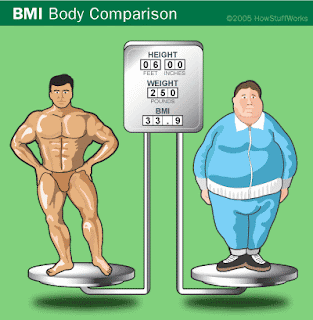The body mass index (BMI), or Quetelet index, is a statistical measure of body weight based on a person's weight and height. Though it does not actually measure the percentage of body fat, it is used to estimate a healthy body weight based on a person's height. Due to its ease of measurement and calculation, it is the most widely used diagnostic tool to identify weight problems within a population, usually whether individuals are underweight, overweight or obese.
It was invented between 1830 and 1850 by the Belgian polymath Adolphe Quetelet during the course of developing "social physics". Body mass index is defined as the individual's body weight divided by the square of his or her height.
The formulae universally used in medicine produce a unit of measure of kg/m2. BMI can also be determined using a BMI chart, which displays BMI as a function of weight (horizontal axis) and height (vertical axis) using contour lines for different values of BMI or colors for different BMI categories.
BMI Calculator
Body weight is a major influence on health throughout life. Obese people are generally less healthy and are more prone to illnesses such as diabetes, hypertension, heart diseases, gall bladder diseases and arthritis. Weigh yourself regularly and know your desirable body weight. Weigh yourself at least twice a month at the same time of the day wearing light clothing.You can calculate your Body Mass Index (BMI) by using the following formula:
CALCULATING THE BMI
Body mass index (BMI) =
weight(kg)
height(m)2
Body mass index (BMI) =
weight(kg)
height(m)2
.
Usage
While the formula previously called the Quetelet Index for BMI dates to the 19th century, the new term "body mass index" for the ratio and its popularity date to a paper published in the July edition of 1972 in the Journal of Chronic Diseases by Ancel Keys, which found the BMI to be the best proxy for body fat percentage among ratios of weight and height, the interest in measuring body fat being due to obesity becoming a discernible issue in prosperous Western societies.
BMI was explicitly cited by Keys as being appropriate for population studies, and inappropriate for individual diagnosis. Nevertheless, due to its simplicity, it came to be widely used for individual diagnosis, despite its inappropriateness.
BMI provided a simple numeric measure of a person's "fatness" or "thinness", allowing health professionals to discuss over- and under-weight problems more objectively with their patients. However, BMI has become controversial because many people, including physicians, have come to rely on its apparent numerical authority for medical diagnosis, but that was never the BMI's purpose; it is meant to be used as a simple means of classifying sedentary (physically inactive) individuals with an average body composition.
For these individuals, the current value settings are as follows: a BMI of 18.5 to 25 may indicate optimal weight; a BMI lower than 18.5 suggests the person is underweight while a number above 25 may indicate the person is overweight; a BMI below 17.5 may indicate the person has anorexia nervosa or a related disorder; a number above 30 suggests the person is obese (over 40, morbidly obese).
For a given height, BMI is proportional to weight. However, for a given weight, BMI is inversely proportional to the square of the height. So, if all body dimensions double, and weight scales naturally with the cube of the height, then BMI doubles instead of remaining the same.
This results in taller people having a reported BMI that is uncharacteristically high compared to their actual body fat levels. In comparison, the Ponderal index is based on this natural scaling of weight with the third power of the height. However, many taller people are not just "scaled up" short people, but tend to have narrower frames in proportion to their height. It has been suggested that instead of squaring the body height (as the BMI does) or cubing the body height (as the Ponderal index does), it would be more appropriate to use an exponent of between 2.3 and 2.7
BMI Prime
BMI Prime, a simple modification of the BMI system, is the ratio of actual BMI to upper limit BMI (currently defined at BMI 25). As defined, BMI Prime is also the ratio of body weight to upper body weight limit, calculated at BMI 25.
Since it is the ratio of two separate BMI values, BMI Prime is a dimensionless number, without associated units. Individuals with BMI Prime < 0.74 are underweight; those between 0.74 and 0.99 have optimal weight; and those at 1.00 or greater are overweight. BMI Prime is useful clinically because individuals can tell, at a glance, by what percentage they deviate from their upper weight limits. For instance, a person with BMI 34 has a BMI Prime of 34/25 = 1.36, and is 36% over his or her upper mass limit. In Asian populations (see International Variation section below) BMI Prime should be calculated using an upper limit BMI of 23 in the denominator instead of 25. Nonetheless, BMI Prime allows easy comparison between populations whose upper limit BMI values differ.
Categories
A frequent use of the BMI is to assess how much an individual's body weight departs from what is normal or desirable for a person of his or her height. The weight excess or deficiency may, in part, be accounted for by body fat (adipose tissue) although other factors such as muscularity also affect BMI significantly (see discussion below and overweight).
The WHO] regard a BMI of less than 18.5 as underweight and may indicate malnutrition, an eating disorder, or other health problems, while a BMI greater than 25 is considered overweight and above 30 is considered obese. These ranges of BMI values are valid only as statistical categories when applied to adults, and do not predict health.
Category | BMI range – kg/m2 | BMI Prime | Mass (weight) of a 1.8 metres (5 ft 11 in) person with this BMI |
Severely underweight | less than 16.5 | less than 0.66 | less than 53.5 kilograms (8.42 st; 118 lb) |
Underweight | from 16.5 to 18.4 | from 0.66 to 0.73 | between 53.5 and 59.9 kilograms (8.42 and 9.43 st; 118 and 132 lb) |
Normal | from 18.5 to 24.9 | from 0.74 to 0.99 | between 60 and 80.9 kilograms (9.4 and 12.74 st; 130 and 178 lb) |
Overweight | from 25 to 29.9 | from 1.0 to 1.19 | between 81 and 96.9 kilograms (12.8 and 15.26 st; 180 and 214 lb) |
Obese Class I | from 30 to 34.9 | from 1.2 to 1.39 | between 97 and 112.9 kilograms (15.3 and 17.78 st; 210 and 249 lb) |
Obese Class II | from 35 to 39.9 | from 1.4 to 1.59 | between 113 and 129.9 kilograms (17.8 and 20.46 st; 250 and 286 lb) |
Obese Class III | over 40 | over 1.6 | from 130 kilograms (20 st; 290 lb) |









0 comments:
Post a Comment